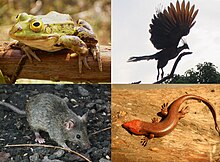Tetrapod
| Tetrapods Temporal range: Late Devonian–Present,367.5–0 Ma |
|
|---|---|
 |
|
| Representatives of extant tetrapod groups, (clockwise from upper left): a frog (a lissamphibian), a hoatzin, a skink (two sauropsids), and a mouse (a synapsid) | |
| Scientific classification | |
| Kingdom: | Animalia |
| Phylum: | Chordata |
| Infraphylum: | Gnathostomata |
| Clade: | Eugnathostomata |
| Clade: | Teleostomi |
| Superclass: |
Tetrapoda Goodrich, 1930 |
| Subgroups | |
|
|
The superclass Tetrapoda (Ancient Greek τετραπόδηs tetrapodēs, "four-footed"), or the tetrapods /ˈtɛtrəpɒd/, comprises the first four-limbed vertebrates and their descendants, including the living and extinct amphibians, birds, mammals, reptiles and some ancient, exclusively aquatic creatures such as the Acanthostega. Tetrapods belong to a group of animals called Tetrapodomorpha. These animals evolved from the lobe-finned fishes around 390 million years ago in the middle Devonian Period, with modern tetrapod groups having appeared by the late Devonian, 367.5 million years ago. The specific aquatic ancestors of the tetrapods, and the process by which land colonization occurred, remain unclear, and are areas of active research and debate among palaeontologists at present.
While most species today are terrestrial, the first tetrapods were fully aquatic. Amphibians today generally remain semiaquatic, living the first stage of their lives as fish-like tadpoles. Amniotes evolved about 340 million years ago (crown amniotes 318 mya), and their descendants drove most amphibians to extinction. One population of amniotes diverged into lizards, dinosaurs, birds and their relatives, while another diverged into mammals and their extinct relatives. Several groups of tetrapods, such as the caecilians, snakes, cetaceans, sirenians, and moas have lost some or all of their limbs. In addition, many tetrapods have returned to partially aquatic or fully aquatic lives throughout the history of the group (modern examples of fully aquatic tetrapods include cetaceans and sirenians). The first returns to an aquatic lifestyle may have occurred as early as the Carboniferous Period, whereas other returns occurred as recently as the Cenozoic, as in cetaceans, pinnipeds, and several modern amphibians.
...
Wikipedia
